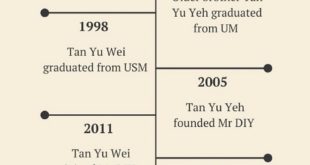We were inspired to write this article after seeing an opinion post that stated small businesses would need a minimum of 24 months of runway in order to survive the recession thanks to the pandemic.
Dictionary Time: Runway refers to the amount of time until your startup goes out of business, assuming your current income and expenses stay constant. Typically calculated by dividing the current cash position by the current monthly burn rate.
Of course having as much runway as you possibly can would be the ideal situation, but we didn’t think 24 months of runway would be realistically achievable for many small businesses.
Nonetheless, we wanted to find out from several small businesses themselves what they thought of this, so we spoke to Farid Nor of SimpanKira, Samantha Ng of Wise Crafters, Ivan Chin of GoLog, and Khairul Faizi Khalid of REMEDi.
1) Farid Nor, Founder of SimpanKira
SimpanKira is an online accounting software meant for other small businesses, and it offers cloud accounting, HR and payroll all in one system.
“Quite frankly, I think having a 24-month runway is a luxury not everyone has,” Farid said, adding that it’s “ridiculously ambitious”.
“Noble, but insane. Most startups I know which didn’t raise any money would depend on month-to-month revenue.”
He believes that startups which are a bit more mature would probably also only have 6-10 months of runway, and it would be dependent on how they performed the previous year.
In order to stay ahead, sales teams must know how long it takes to bring in money with the invoices that they’re chasing, as the company sales cycle determines how much runway a small business can save too.
If the startups have previous data on how their sales were performing, most likely they can factor this in assessing their expense budget and how long they could survive if they can’t make the sales.
Farid Nor, SimpanKira
Desperate times call for desperate measures, so small business owners need to do whatever it takes to stay afloat now, whether it’s through negotiating with suppliers, asking clients to pay up, or cutting any expenses not related to money generating activities.
Despite the demand of SaaS in Malaysia, Farid shared that we’re still largely in a traditional mindset due to the reluctance of business owners from baby boomer generations to adopt technology in their working environment.
“Even when we do sales, the prospects would still require us to come to their office and do the demo, instead of them reading everything on our website, looking at the tutorial, and doing research on the web,” he lamented.
Because of this, their own sales have been impacted by the pandemic.
2) Samantha Ng, Co-founder of Wise Crafters
Wise Crafters is a startup selling healthy foods that started online but has since developed into a physical oatmeal and kefir bar in Petaling Jaya.

Like Farid, Samantha agreed that 24 months of runway would be ideal to survive the recession, but realistically, she thought 6-12 months would be the answer.
“During this pandemic, many small businesses have zero or very little income. The businesses that had 18 months of runway to survive based on normal days’ estimation might not be meeting their expectations as the loss is much bigger now. Perhaps it’s been reduced to 12 months or less,” she shared.
With their own runway being affected, Wise Crafters directed their offline customers online and are focusing on online acquisition instead.
“We will take the budget from previous runway and reinvest in website, packaging, and customer service,” Samantha told us.
Some other ways she shared that small businesses (retail ones in particular) could save on what little runway they had left would be relocating and making use of social media.
Most retail businesses spend a huge budget in getting a “hot spot”. Perhaps now is the time to rethink this: Can you survive without having your business in this prime location?
Samantha Ng, Wise Crafters
“If the answer is ‘yes’, I think relocation will save us from the recession,” Samantha said.
3) Ivan Chin, Founder of GoLog
GoLog is an app for on-demand logistics that finds you the nearest driver in Selangor and Negeri Sembilan to deliver your packages anywhere across Malaysia.
Ivan sees 24 months of runway as a safe zone for SMEs to handle any impact from the economic crisis, but believes that, realistically, most SMEs don’t even have 3 months of runway.
“The monthly burn rate is high and some high-profile clients might have payment terms. The company at least must have a 6-month runway with a contingency plan to generate more income,” he stated, drawing from his own experience.
GoLog itself managed to switch from providing B2B services for businesses to providing B2C ones instead, through delivering frozen, chilled and fresh essential goods to customers.
This is in line with Ivan’s advice to seek an alternative source of income ASAP in order to maintain or build one’s business runway.
They need to observe and check what is their current business model, whether it’s able to support the needs of the market demand during this MCO, and they can add on value to generate income by partnering with other industries.
Ivan Chin, GoLog
What GoLog did enabled it to generate 2x the sales revenue during the MCO as compared to before, thus its runway wasn’t affected much.
4) Khairul Faizi Khalid, Founder of REMEDi
REMEDi is a cloud based healthcare database platform that enables clinics, hospitals and patients to store medical data securely and in a paperless way.

“With current circumstances where a lot of businesses have already been struggling before the pandemic, it’s very hard to justify having a certain amount of runway to survive,” Khairul said.
“The most important thing right now is to survive! That means maintaining low expenses and acquiring a steady albeit small income/opportunity that you can get during this testing time.”
While he doesn’t agree that a strict 24 months of runway is needed, he thinks 12-24 months would give companies enough stability and time to put their plans into action during a recession.
“Learning from experience, this is a pragmatic time frame needed for a proper and holistic plan to turn around the company to set its course, on a short-term basis,” he said.
Aside from keeping expenses low, Khairul also shared that working on leads that don’t hurt you in the long run is beneficial to building up your runway.
There must be a balance between pursuing a big lead that will incur large expenses now for the income that will come much later (e.g.: doing jobs for big corporations) VS pursuing something smaller in revenue but doesn’t incur much expenses to get it operationalised and getting the revenue in fast (e.g.: small jobs that pay upfront).
Khairul Faizi Khalid, REMEDi
For REMEDi, COVID-19 has affected its business in the right direction by speeding up and hastening digital healthcare adoption.
In fact, with them being approached by potential customers instead of the other way round, REMEDi has come up with a new Virtual Clinic offering.
In short, it uses REMEDi’s proprietary Electronic Medical Record (EMR) platform and allows patients to experience the entire clinical experience (from pre-consultation up to getting their prescriptions delivered).
-//-
Across the different industries, it seemed that small business owners definitely had different ideas of what the ideal runway would be, as well as how to go about achieving it.
However, it’s clear that all of them found a strict 24 months of runway to be a bit too idealistic and unrealistic.
This is especially since the pandemic was something that came out of left field in a way, and many businesses were unprepared for its impact.
Even if businesses had a “safe” amount of runway prior to the pandemic, the loss of sales channels for many industries would mean that the runway is running out faster than planned.
Across Malaysia (and the world), drastic measures have been taken with lay-offs and pay cuts, to name a few, but there have also been businesses who found a way to quickly pivot and ride out the storm.
I believe that this is perhaps one of the best ways to ensure business survival at this current moment, particularly if you can offer a product or service that caters to the market’s current needs.
- You can read more COVID-19 related topics we’ve written about here.
Featured Image Credit: REMEDi / GoLog / Wise Crafters / SimpanKira



